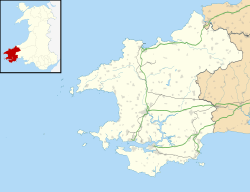History
The Welsh manor (maenor) of Castle Morris lay within the ancient Cantref of Pebediog (later the Hundred of Dewisland). [1] The manor was granted to Maurice FitzGerald, Lord of Lanstephan by his brother David FitzGerald, then the second Norman approved bishop of St David's, [2]
Castle Morris may have acquired its name (Castell Maurice) in the 12th century from Maurice FitzGerald, but it may be a far more ancient relic of the pre-Norman Welsh name - Castell Marlais - Marlais then being the name of the reach of the Western Cleddau river which flows immediately below the village.
In 1302 Sir John Wogan, chancellor of St David's, secured a grant of the manor of Castle Morris for the bishop of St David's. [3]
To the northeast of the village crossroads is the Grade II-listed farmhouse of Pencnwc, a substantial early and late 19th century building that was formerly part of the Bishop of St Davids' estate, leased by Abraham Leach in 1843, and occupied by William Evans. [4] The farm occupies the site of a former timber castle with stone foundations, of which there are no longer any visible remains.
There was a village shop in 1902. [5] From 1906 George Evans was the village smith. [6] In 1910 the village shop, smithy, cottages and 43 acres of land were put up for auction, but bidding only reached £1,900 and the lot was withdrawn. [7] The village had a post office in 1916. [8]
This page is based on this
Wikipedia article Text is available under the
CC BY-SA 4.0 license; additional terms may apply.
Images, videos and audio are available under their respective licenses.


